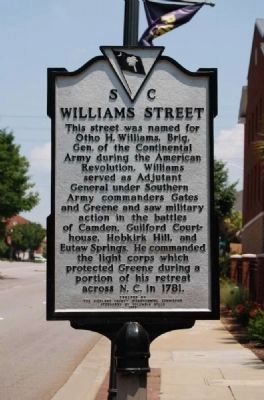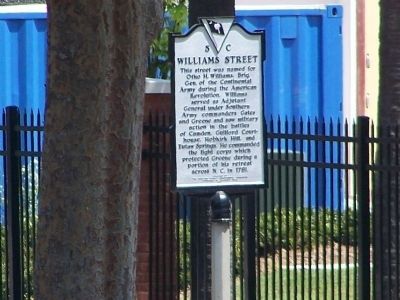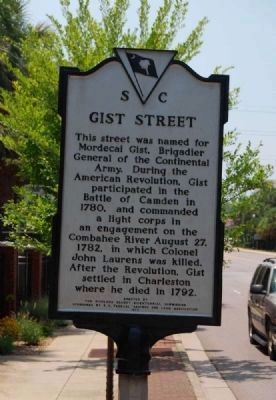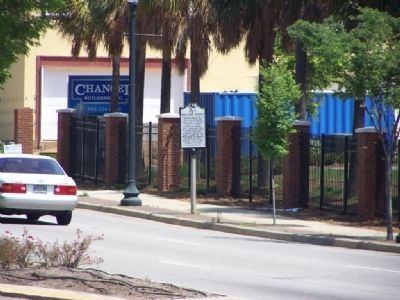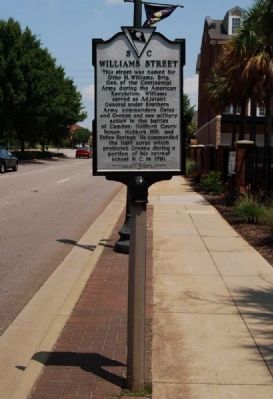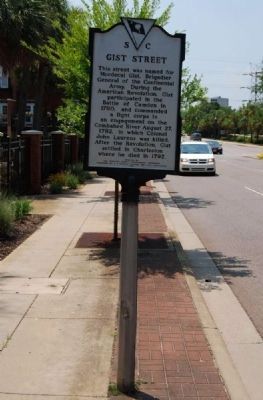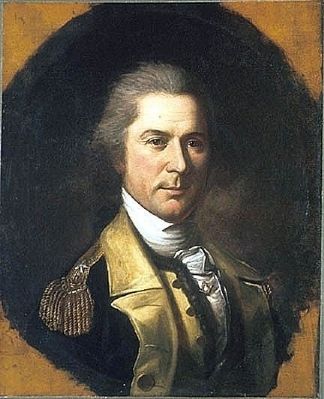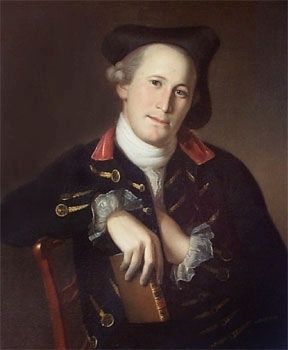Midtown - Downtown in Columbia in Richland County, South Carolina — The American South (South Atlantic)
Williams Street / Gist Street
Erected 1977 by Richland County Bicentennial Commission, sponsored by Columbia Mills. (Marker Number 40-62.)
Topics. This historical marker is listed in these topic lists: Colonial Era • Military • Patriots & Patriotism • War, US Revolutionary. A significant historical year for this entry is 1781.
Location. 33° 59.824′ N, 81° 2.813′ W. Marker is in Columbia, South Carolina, in Richland County. It is in Midtown - Downtown. Marker is on Gervais Street (U.S. 1) near Williams Street, on the right when traveling east. Touch for map. Marker is in this post office area: Columbia SC 29201, United States of America. Touch for directions.
Other nearby markers. At least 10 other markers are within walking distance of this marker. Doolittle Raiders (within shouting distance of this marker); Columbia Canal (about 500 feet away, measured in a direct line); Huger Street (about 600 feet away); Harnessing Water Power (about 600 feet away); Gervais Street Bridge (about 600 feet away); 1896 Power Plant (about 600 feet away); Congaree River Bridges (about 700 feet away); Confederate Printing Plant (approx. ¼ mile away); State Dispensary Warehouse (approx. ¼ mile away); Joseph D. Sapp Memorial Bridge (approx. 0.3 miles away). Touch for a list and map of all markers in Columbia.
Also see . . .
1. Otho Holland Williams. Otho Holland Williams (March 1, 1749 – July 15, 1794) was a Continental Army officer from Maryland in the American Revolutionary War. (Submitted on August 15, 2009, by Brian Scott of Anderson, South Carolina.)
2. Battle of Camden. The Battle of Camden was a major victory for the British in the Southern theater of the American Revolutionary War. (Submitted on August 15, 2009, by Brian Scott of Anderson, South Carolina.)
3. Battle of Guilford Court House. The Battle of Guilford Court House was a battle fought on March 15, 1781 inside the present-day city of Greensboro, North Carolina, USA, during the American Revolutionary War. (Submitted on August 15, 2009, by Brian Scott of Anderson, South Carolina.)
4. Battle of Hobkirk's Hill. The Battle of Hobkirk's Hill (sometimes referred to as the Second Battle of Camden) was a battle of the American Revolutionary War fought on April 25, 1781, near Camden, South Carolina. (Submitted on August 15, 2009, by Brian Scott of Anderson, South Carolina.)
5. Battle of Eutaw Springs. The Battle of Eutaw Springs was a battle of the American Revolutionary War, the last major engagement of the war in the Carolinas. (Submitted on August 15, 2009, by Brian Scott of Anderson, South Carolina.)
6. Mordecai Gist. Mordecai Gist (1743–1792) was a member of a prominent Maryland family who became a general in command of the Maryland Line in the Continental Army during the American Revolutionary War. (Submitted on August 15, 2009, by Brian Scott of Anderson, South Carolina.)
7. Mordecai Gist, Find a Grave Entry. Born the son of Thomas and Susanna Gist in Baltimore, Maryland. In 1774, with his personal fortune, Gist established the Baltimore independent company, which became the Maryland 5th Infantry. (Submitted on August 15, 2009, by Brian Scott of Anderson, South Carolina.)
Additional commentary.
1. Notable commander, Colonel Otho H. Williams
The 6th Maryland Regiment was organized on 27 March 1776 composed of eight companies of volunteers from Prince Georges, Queen Anne's, Frederick, Cecil, Harford, and Anne Arundel counties in the colony of Maryland.
It was authorized on September 16, 1776 for service with the Continental Army and was assigned to the Main Army on 27 December 1776. On 22 May 1777 the regiment was assigned to the 2nd Maryland Brigade. It was re-organized to nine companies on 12 May 1779. The 2nd Maryland Brigade was re-assigned to the Southern Department on 5 April 1780. The regiment would see action during the Battle of Brandywine, Battle of Germantown, Battle of Monmouth, Battle of Camden and the Battle of Guilford Court House. The regiment was disbanded on January 1, 1783 at Annapolis, Maryland.
— Submitted April 29, 2008, by Mike Stroud of Bluffton, South Carolina.
2. General Mordecai Gist: An Officer of the Revolution and Grand Master of South Carolina
General Mordecai Gist was one of the patriots of the Revolution whose name is alike honorably connected with the annals of Masonry and with the history of our country. His ancestors emigrated from England to Maryland at an early day, and settled in Baltimore. He received a mercantile education, and was employed in that business when the war of the Revolution commenced. It is not known at what age, or in what lodge, he became a Mason. Two lodges of Ancient York Masons were chartered in the city of Baltimore, by the Grand Lodge of Pennsylvania, in 1770, and it is-probable he was made in one of these, as he had risen to the rank of Worshipful Master previous to the Revolution.
When the war of the Revolution commenced, the young men of Baltimore formed an independent company, of which they elected Mordecai Gist as captain. This was the first military organization in Maryland for the defence of American liberty. In 1776, Mr. Gist was appointed major of a battalion of Maryland regulars, and bravely led his men in the terrible conflict on Long Island in that year. For his bravery on that occasion he was commissioned as a colonel in 1777; and in 1778, while in command of his Maryland troops, at Locust Hill, near New York, he was attacked by the combined forces of Generals Simcoe, Emerick, and Tarleton, of the British army, but he discovered their approach in time to escape from their hands. He was engaged in the battle of Paoli, where the terrible massacre of American troops took place, and distinguished himself soon after at the battles of Germantown and Whitemarsh.
In January of 1779 he was appointed by Congress a brigadier-general in the Continental army, and was honored with the command of the second Maryland brigade. In the winter of 1779-80 he was encamped with his command at the general headquarters of the American army at Morristown in New Jersey.
While in their winter-quarters here, the Masonic Brethren in the army celebrated the festival of St. John the Evangelist. The meeting was held under the charter of the American Union Lodge, and Washington and a large number of distinguished officers of the f American army, who were Masons, attended on the occasion. The Masonic Lodges of America had formerly all owed their existence to, and been dependent upon, the Grand Lodges of Great Britain; but the misfortunes of war had caused all intercourse to cease between them and their parent head ; and although some provincial Grand Lodges still existed in this country, they were regarded but as the subordinates of the Masonic powers in Great Britain by whom they were created.
At this army festival of the Masonic Brethren in 1779, a petition was presented, setting forth the condition of Masonry hi the new political state of the country, and expressing a desire that a general union of American Masons might take place under one general Grand Master of America. A committee was appointed to take the subject into consideration, consisting of distinguished Masons from each division of the army.
The Committee met in convention on the 7th of January, 1780, and chose General Mordecai Gist as their President, and General Otho Holland Williams as their Secretary. An address to the different Grand Masters of the United States was drawn, considered, and adopted on the occasion, setting forth the same general views as those embraced in the petition they were called on to consider, and asking that measures might be taken to secure a union of all the Lodges of the country under one American head. Copies of this address were sent to the different Grand Masters in the United States; and although the Convention had delicately forborne to mention the name of Washington as their choice for General Grand Master, yet it was well understood that such was their wish.
In the following spring, General Gist was sent with his command to assist General Gates in South Carolina. While at the North, he and the Brethren in his troops had enjoyed Masonic privileges in the different Masonic Lodges in the army. No Military Lodges existed in the Southern army, and he therefore applied to the Grand Lodge of Pennsylvania for a warrant to hold one in the line under his command, and a warrant was granted, constituting him its Master. This Lodge was numbered 27 on the Pennsylvania Grand Lodge registry. Its warrant bore date, April 4, 1780.
During the same year the battle of Camden, in South Carolina, occurred, in which, although the Americans were defeated by Cornwallis, General Gist won for himself an imperishable renown. Even after the battle was irretrievably lost, it is said that he rode from point to point, amidst a storm of fire, and by his own enthusiasm and bravery preserved his broken troops from annihilation. He was afterwards engaged in the conflict at Yorktown, in 1781, and had the proud satisfaction of seeing the haughty Cornwallis become a captive to American bravery.
After the capture of Cornwallis, General Gist joined the southern division of the army under General Greene ; and when the army was remodelled in 1782, General Greene gave him the command of the " light corps." It was a part of his command, under General Laurens, that dealt one of the last blows to the enemy in an engagement on the banks of the Combahee. Thus was it the fortune of General Gist to fight gallantly for his country from the commencement to the close of the war. He had heard its first clarion notes and its last battle-shout; and when it was closed,' he retired to a plantation which he had purchased near Charleston, in South Carolina, and, like Washington, engaged in agricultural pursuits.
The warrant from the Grand Lodge of Pennsylvania to General Gist, empowering him to hold Lodges in the Maryland line of the army, was, by resolution of that Grand Lodge, vacated at the close of the war; but in 1786 another was granted to him to hold a Local Lodge, with the same registry number (27), at Charleston, South Carolina, by the same Grand Body. This warrant constituted General Mordecai Gist, Master, and Thomas B. Bowen and Ephraim Mitchell, Wardens. In 1787 the Lodges of Ancient York Masons in South Carolina united to form an Independent Grand Lodge for that State; and of this Grand Body General Gist became the first Deputy Grand Master.
The Hon. William Drayton, chief-justice of the State, was at the same time Grand Master. He was the first Grand Master of Ancient York Masons in that jurisdiction. General Gist was his Deputy in 1787-88- 89, and succeeded him as Grand Master in 1790, and held the office for two years, when he was succeeded by Major Thomas B. Bowen, who had been his first Senior Warden under his Pennsylvania local Lodge warrant.
It was while General Gist was Grand Master, in 1791, that Washington visited, as President, the Southern States, on which occasion the Masonic correspondence between these two distinguished Brothers took place which we have given in our sketch of Washington. It was the last official act of General Gist which we have seen. He died in the following year, in September (1792), leaving two sons, one of whom he named Independent, and the other, States. He was, at the time of his death, fifty years of age. (Washington and the Masonic Compeers by Sidney Hayden (1874), pgs 390-395.)
— Submitted August 15, 2009, by Brian Scott of Anderson, South Carolina.
Credits. This page was last revised on February 16, 2023. It was originally submitted on April 29, 2008, by Mike Stroud of Bluffton, South Carolina. This page has been viewed 1,369 times since then and 28 times this year. Last updated on September 8, 2008, by Brian Scott of Anderson, South Carolina. Photos: 1. submitted on August 15, 2009, by Brian Scott of Anderson, South Carolina. 2. submitted on April 29, 2008, by Mike Stroud of Bluffton, South Carolina. 3. submitted on August 15, 2009, by Brian Scott of Anderson, South Carolina. 4. submitted on April 29, 2008, by Mike Stroud of Bluffton, South Carolina. 5, 6, 7, 8. submitted on August 15, 2009, by Brian Scott of Anderson, South Carolina. • Craig Swain was the editor who published this page.
